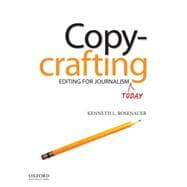From newspapers to Twitter®, the media's ability to deliver news and interact with audiences is constantly changing. In Copycrafting, author Kenneth Rosenauer provides aspiring journalists and copyeditors with the essential tools for delivering content effectively and correctly, regardless of the media platform. More than just the basics of copyediting and AP style, this complete package provides a wealth of examples and exercises for practice. This allows students to actively learn the editing skills that they will need to flourish in the constantly evolving media landscape.
Features
* Excellent coverage of AP style with explanations and examples
* Tips on writing headlines, editing problem leads, editing images and designing pages
* Stories for students to edit
* An Appendix that contains a directory for students to consult as they complete the exercises
* A Solutions Manual with corrected versions of every exercise in the book, available to instructors on the Companion Website (www.oup.com/us/rosenauer)








